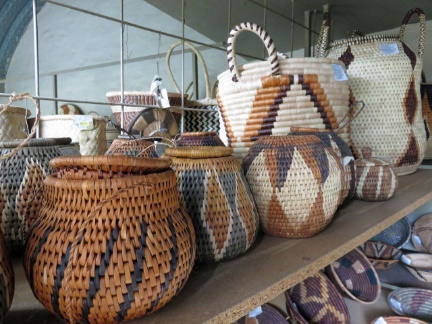Baskets encapsulate beauty and functionality with seamless fusion. The age-old skill of basket weaving has been passed on and perfected through the generations. The result: earthy, intricate and immaculate works of art.


At the Living Museum of the Mbunza near Rundu where a small group of people share the traditions of the Kavango people, Sebron Ruben gave me an idea of the importance they hold historically in the culture. I couldn’t help smiling when he told me how traditionally baskets were not only used as vessels for carrying, as plates to eat off and for separating grain from chaff, but they were also necessary to prove your worth to your mother-in-law. “If you didn’t know the craft,” he said, “she was entitled to return you to your parents!” It was just as important for a man to know how to weave a mat, so he could make the first sleeping mat that he would share with his future wife.
Those days may be long gone, but baskets still form an integral part of the traditional homestead. In the four Owambo regions that span the area north of Etosha National Park, it’s still common to see women in the homestead yards weaving baskets when they have completed their work in the mahangu fields and their many household chores.

The tough long leaves of the makalani palm trees (Hyphaene petersiana), which characterise parts of this vast area, provide the perfect material. It is said that the ancient migratory routes of elephants are responsible for the palm belt that runs through the northern reaches of Namibia, and the elephants’ generous legacy lives on. While the hard fruit of the makalani is eaten by both people and animals, and the inner core is carved into keyrings and other curios, the leaves are cut into strips, softened by boiling and dried in the shade. They are then threaded through the eye of a large needle in readiness for the work to begin, starting from either a square or rounded central piece.



The Oshiwambo baskets generally are made with larger coils than those of other areas and can be made with a tight, loose or cross weave. The shapes are dictated by their function: the deep ontungwa basket for carrying fruit or mahangu (pearl millet), the slightly rounded elilo basket used as a plate and the flat ongalo basket used for winnowing. Brown dye for the designs is made from charcoal and the bark of the bird plum tree (Berchemia discolor), and red dye from rusty tins and sorghum leaves.

While it is traditionally a woman’s role to make baskets, men weave mats, hats and the large eshisha granary baskets that are used to store the staple, mahangu, or sorghum. They are made with the thin sticks of the bitter bush, wound together with twine made from mopane tree bark. These massive granary baskets, which can take up to two-months to make, are sealed with clay and raised above the ground to protect the grain from insects. The aim is to be able to store the grain for two to three years in case of drought, a common occurrence in the region. The eshisha granary baskets play an important part in the lives of the Owambo and are often seen in traditional homesteads.


Moving further to the east, the Zambezi (former Caprivi) Region has produced many generations of skilled basket makers. Palm leaves are also used in this area to make baskets, as are various grasses, roots, saplings and reeds. Different shaped baskets make their appearance here: the bag-shaped baskets of the Khwe, the square-based baskets of the BaSubiya and the large tightly-woven cone-shaped and small powder baskets of the Mbukushu.
Dazzled by the beauty of baskets and cognisant of the time spent making them and the skill involved, I am often torn between using them as fruit bowls or mounting them on the wall. They are usually works of art, suitable to be displayed in art galleries around the world.

As with many traditions of old, the hope is that basket-weaving will endure even with the convenience of plastic containers and the lure of the modern world and the city for the younger generation. And, importantly, that moms - and grandmoms - will continue to pass on the skill to their daughters, in whom the future of basket-weaving lies.
Recommended outlets:
Windhoek: Namibia Craft Centre
Kongola: Mashi Crafts
Katima Mulilo: Katima Craft Centre
Ulukonda, just south of Ondangwa: Nakambale


